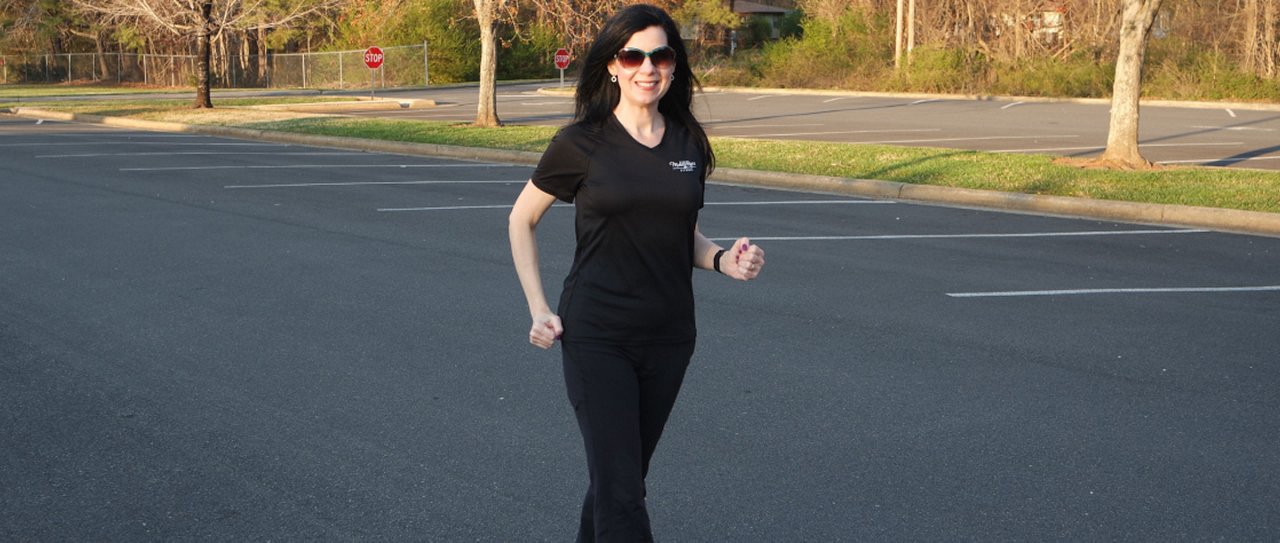How I walked off 60 lbs – and you can, too

Today as a fitness professional and healthy lifestyle blogger, people are often surprised to find out that I used to struggle with large fluctuations in my weight, and with sticking to exercise. Indeed I did, for decades. But at age 41 I finally overcame all that, and it changed my life. Turns out the solution was with me the whole time – my own two feet!
How I got from there to here
Over the years, my weight was up and down – mostly up.
Nothing really worked for me. It was discouraging. But eventually, I got to the point where I just wasn’t feeling great. I was stiff and sore a lot, and low on energy. I was concerned enough to request medical tests, but they always came back normal.
One day I’d had enough. I was sick and tired of feeling sick and tired. I knew I needed to get my body moving to try to alleviate the stiffness and tiredness.
That’s when I happened to see a like-new treadmill for $100 online, a bargain too good to pass up. I thought, “Walking – I can do that!”
Unlike the past, this time I decided to start really small with exercise. I started walking for 15 minutes at a scheduled time every day. The next week I did 16 minutes a day. Each week I added another daily minute or two. Gradually, I increased speed as well as time.
But the best part was how much better I started feeling!
I wasn’t losing weight at first, but I didn’t give up like I had every other time in the past. I didn’t want to go back to feeling tired and achy.
All the effort I’d been putting into exercise made me want to start eating better, too. But this time, I didn’t go on a diet. Instead, I began focusing more on nutrition, portion size, and cutting back on excess calories. I started small here, too – with one little change at a time. I built on that over time so that I could keep it up without feeling deprived.
Over the next year I went on to lose all the extra weight, and in the process experienced an awakening: When you are healthy and feel good, it benefits every area of your life. Not only am I physically stronger and more energetic, but I am also happier, too. Exercise and good nutrition transformed me, inside and out.
Why walking?
Walking is one of the simplest exercises there is, yet incredibly beneficial. There are so many advantages to walking.
You can do it anytime, anywhere. You can walk outdoors at a park, around your neighborhood, or downtown. You can even do it indoors – around your house or office building, or on a treadmill.
Improves your health. Walking helps prevent or improve type 2 diabetes, high blood pressure, heart disease, and stroke. It makes your bones, muscles, and joints more resilient.
It’s great for your brain and mental health, too. Walking helps improve memory and thinking, reduces the risk for Alzheimer’s, and helps prevent or improve depression.
It’s enjoyable.
Walking is free and doesn’t require any equipment. There’s less impact on your joints and feet than running or traditional aerobics.
It’s one of the best exercises you can do.
How walking can help you lose weight
If weight loss is our goal, how can we use walking to get there?
Here are some strategies for success.
Set a time to exercise. First and foremost, I advise you to set a daily time to walk and stick to it.
I got up (and still do) early in order to exercise before work, and that worked great for me rather than waiting until the end of the day when I was too tired and busy. For me, this was a game-changer.
Set a time that works for you. Put it on your schedule. Put it in your phone calendar so you get reminders about it.
Decide you’re willing to do the work. Can you really lose weight by walking? Yes, if you’re willing to put in the time and effort it takes to effect physical change.
While any amount of exercise you do is better than nothing, it’s the consistency, dedication, and effort you put into it that will make the difference between losing weight and getting fit, or not.
Pick up the pace to burn more calories. When we say we want to lose weight, what we really want is to reduce body fat. Cardio exercise burns fat.
But to maximize this, a leisurely stroll won’t do. To make walking a fat-burning cardio exercise, we need to up the time and intensity.
Here’s an example. Let’s say you are a 185-pound person. If walking 3 mph (such as walking a dog), you will burn 277 calories an hour. But if you walk faster at 4 mph, you will burn 420 calories per hour! Plus, when you exercise you’re stoking your metabolism so that your body burns more calories throughout the day.
What I did was power walking, also called cardio walking. I pumped my arms, I walked with small, quick steps to fast music. I got my heart rate up into my training zone and worked up a sweat every time. I like to say that “I’m a runner, but my version of running is fast walking.” That’s the kind of effort I put into it, and I was very dedicated to my workout schedule.
Aim for 30 to 60 minutes a day. It’s ok to start small though. Try adding five minutes to your daily walk time every week until you get to at least 30 minutes a day.
I started with 15 minutes a day at around 3 mph. I did it every day, so it would become a habit. Over time, I worked my way up to 60 minutes a day at 4 mph, and added a rest day. During my workouts, I incorporated intervals of a fast pace with a moderate or slower pace, so that I could keep going for the duration. Always rest or slow down when you need to.
Stay hydrated. It’s important to drink water before, during and after exercise. Avoid sports drinks and sugar-added beverages. Just drink water.
Remember: You can’t out-exercise a bad diet. If you’re not losing any weight or inches, or if you are gaining weight, the most likely reason is that you are consuming more calories than your body needs – and you’re probably not even aware that you’re doing it. Use a written journal or a food and activity app to track your calories and exercise, so that you are mindful of how much you are eating, drinking and moving.
If you’re struggling with this, consider meeting with a registered dietitian. They can create a nutrition plan tailored to your needs and preferences, and provide ongoing support.
Don’t make it all about the scale. The scale isn’t the only measure of progress! Your body composition (as in, your percentage of body fat vs. muscle) is more important than your weight.
Keep track of your body measurements.
When you are an exerciser, results often show up in measurements before the scale. I recommend weighing yourself weekly and taking body measurements monthly. Log these numbers so you can track them.
Keep going, even when progress feels slow. Persistence really is the secret to success. You need to keep going and continue your plan, no matter how small and slow your progress feels. It always feels slow while you’re going through it.
We’ve been conditioned by magazines, TV commercials and the weight loss industry to believe that losing weight is fast and effortless. In reality, healthy, sustainable weight loss isn’t a quick process. It takes time and effort to build new habits, adjust to healthier ways of eating, and for your body to burn the extra fat it’s stored.
Over the year that I was losing the weight, it felt slow at times. Sometimes there was no change on the scale, even though I was doing all the right things. I learned to be patient and accept that plateaus are a natural part of the process as my body adjusts, and I didn’t let it deter me this time around. I stayed the course and just kept going. So can you!
Browse related articles

Blue Cross and Blue Shield of North Carolina does not discriminate on the basis of race, color, national origin, sex, age or disability in its health programs and activities. Learn more about our non-discrimination policy and no-cost services available to you.
Information in other languages: Español 中文 Tiếng Việt 한국어 Français العَرَبِيَّة Hmoob ру́сский Tagalog ગુજરાતી ភាសាខ្មែរ Deutsch हिन्दी ລາວ 日本語
© 2024 Blue Cross and Blue Shield of North Carolina. ®, SM Marks of the Blue Cross and Blue Shield Association, an association of independent Blue Cross and Blue Shield plans. All other marks and names are property of their respective owners. Blue Cross and Blue Shield of North Carolina is an independent licensee of the Blue Cross and Blue Shield Association.




